How To Draw An Iris Eye
Before you kickoff drawing
Three quick things y'all need to do before we get to cartoon:
-
Cull a reference photo

Here is the reference motion-picture show I'll be using. I chose this one because the eye in it is broad open and you lot can see the entire iris which makes explaining some steps easier. If you want, you lot can choose your own photo and follow my directions.
-
Apply the grid (if you choose to utilise it)
I divided my film into smaller parts in Photoshop. You can practice the aforementioned in MS Paint. Or cheque out a free app that'll do that for you lot – download 1 from hither.
If you lot're adding the filigree to your own photo, don't use also many lines. We don't desire the picture show to be unreadable. If y'all accept problems with the sketch afterward, cut a problematic foursquare with an additional line.

If you lot're drawing with me, open this image in a new tab so you lot're able to return to it whenever you need without scrolling back to this part.
-
Collect all the necessary tools
Here is a list of tools I used:
- Good quality paper
If yous're here to practice, feel free to use your sketchbook. If yous're creating a legitimate cartoon I recommend working with improve quality paper. I use Strathmore Bristol Shine paper for almost of my drawings. It's very popular among pencil artists. And affordable!
- 4B and 6B pencil
My favorite pencils are Faber Castell Goldfaber 1221. What I like about them the most is that I have effectually l of them and not a single one e'er broke. I keep dropping them, they go on keeping their leads in 😉
- Mechanical pencil with a 2B lead
That's the one I use about frequently. I could create a whole drawing with information technology, but I think it's smarter to use softer pencils mentioned above for shading. So we'll use a mechanical pencil for details.
- Blending stumps
For blending, of class.
- Makeup brush
Another tool I utilize to blend. Information technology works wonders with vivid shades, where the stump could cause too much smudging. I apply a makeup castor instead of a paintbrush because information technology's softer.
- Kneaded eraser
The most important thing in every pencil artist's toolset. Use information technology for erasing, shading, highlighting, yous proper name it. This eraser can exist molded into any shape. It picks graphite off the paper, in layers, without leaving any mess. I recommend getting a couple of those, every bit you'll use them often and they'll get muddied pretty quick.
- Pen or pencil eraser
I have both. Pencil eraser for its convenience and pen eraser for the finest lines.
Now, to the actual tutorial!
How to draw eyes step by footstep
-
Sketch a uncomplicated eye outline

Sketch out all the bones shapes. Then, with lighter strokes, marker the outline of more prominent shadows yous're able to notice at this point.
I started with the pupil and continued adding shapes effectually information technology.
How to sketch eyes using filigree – proper order
- Pupil
- Iris
- Light reflection
- General eye outline
- Inner corner elements
- Crease
- Waterlines (eyelid rims)
- More prominent shadows and wrinkles
- Countenance
- Line connecting the outer corner with the brow
Hover your mouse over the picture or tap it to meet the numbers.
Remember that the pupil and the iris should exist circles. Be sure to look at them from a slightly different angle and see if they're more or less round. Another thing to have in listen is that the pupil should exist right in the center of the iris.
Now, with every centre comes a spot of reflected lite. The shape of it is defined past the calorie-free source, like a lamp or a window (in our example it's a window). Information technology's common to observe multiple highlights in your model'southward heart. I usually choose to ignore them – 1 bigger spot is enough – it makes the eye pop and keeps the drawing clean. You lot'll achieve the best results if the reflection cuts into the educatee, and then it'south half in that location and half on the iris.
Every bit far every bit waterlines are concerned, keep in mind that they get thinner closer to the inner eye corner. Visibility of the upper waterline depends on the bending from which we look at the eye.
Final only not least: exist careful with lines that span across multiple squares. After you've drawn the contour in each foursquare, look at the whole line over again and smooth it out.

Pro tip: When drawing using a grid, always remember to bank check what that grid has made you do. Draw in particular squares separately to ensure good proportions. And so look at the whole flick and cheque if the shapes await decent, if they connect smoothly and whether or not you lot need to move things around a lilliputian.
-
Fill the pupil

First, you may want to roll your kneaded eraser on the drawing a couple of times to make the sketch less visible. I left information technology as is so you can see it amend.
The darkness of the student will ascertain the contrast of our drawing. Fill it in properly, using a soft pencil (at to the lowest degree 4B). Add layers until you reach a shade the closest to blackness.
If the highlight on your eye spills onto the pupil, keep that area white! It will be impossible to erase it later without whatever graphite residual showing.
-
Accentuate the iris

In the next couple of steps, I'm going to show yous how to draw an iris.
Showtime, fill in the whole iris. Tilt your pencil slightly to keep the strokes soft, similar on the right side of the picture below.

Leave the light reflection white. It'south the second factor defining the dissimilarity. Make it the brightest chemical element of your eye drawing.
Using a much darker shade, define an outline of the iris. Brand that line pretty thick.
If you're drawing a unlike eye, in which the lids cover some office of the iris, leave that part unfilled.
-
Alloy the iris

Before any blending, brand sure that you've erased gridlines around the iris. We need that area to be clean because we'll non only blend the inside, but also the outer edge of the iris. If we don't erase these lines, they'll stay visible and trying to erase them later on will destroy our perfect blend.
Use a blending stump to smoothen the inside of the iris. I like to blend in the opposite direction to that of the pencil strokes. The truth is I commonly end upward blending all over the identify, so don't think of it equally a rule.
The last pace here is smudging that dark circle on the outside of the iris we've made before. Utilise the tip of a stump to do that, keeping it slightly tilted.
Pro tip: Using your stumps' tips is the quickest way to ruin them. All the same, I exercise own that one stump that's already had enough and I tin damage it a little bit more. So should yous.
Showtime, dilute the nighttime circumvolve towards the pupil. Then, smooth out the outer border. If you look at any middle, y'all'll detect that the border between the iris and the sclera is soft rather than sharp.
-
Fill up the iris with some basic lines
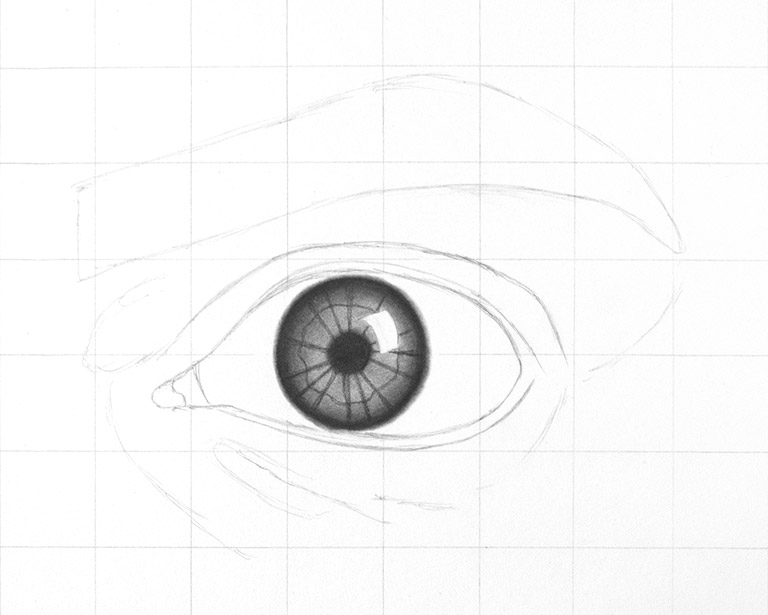
If your goal is to create a hyperrealistic center cartoon, the side by side iv steps are crucial – we'll draw a detailed iris.
If you feel like it'south too much, that's okay. Even without these details, your drawing will look impressive. All these odds and sods may also exist redundant if you're creating a portrait or a whole person sketch, where you lot won't be able to run across such tiny details anyway. If so, feel gratis to skip to stride number ix.
Otherwise, depict a wiggly circle around the pupil. This ring usually separates unlike colors, shades or structures in the iris.
Next, add together a couple of straight lines around the pupil. They should start right in the center of the pupil and end at the iris edge (hover over the image). Make sure the altitude between them is irregular – the whole iris is quite a mess and we desire to brand it every bit disordered equally possible.
Pro tip: Use a pencil that'due south a scrap worn out so the lines have some thickness.
-
Add together dark spots and more lines

Condense the lines: toss in some shorter ones – offset or ending at the wiggly inner circle.
Add a few double lines that wait like orange vesicles (or teardrops). You tin can fill them in or not.
Finally, fill up in a couple of areas created by the net of lines.
(Hover over the epitome to see what I hateful)
-
Erase bright spots

Look at the reference picture and examine the iris structure over again.
Can you run into all the brighter parts? We're going to rub them out. How cool is that? It's my favorite function of a drawing process – actually drawing with an eraser.
Pro tip: Use an eraser in the course of a pencil, or an eraser pen, to rub out piddling details precisely.
As you tin can run across, I erased a part of a wiggly ring, as well equally some lines and larger areas. A lot of them, really. Exercise whatever you want here. I insist. Take some fun. Information technology's really satisfying to let go while erasing!
-
Add even more than detail

It's time to have some fun once again.
Add more than "orangish vesicles", black or white. Erase some more than lines. This fourth dimension make them even whiter. Feel free to connect a couple of lines and then they create little veiny structures.
Fix the contrast and add more depth by concealment some areas.
Terminate with erasing the big white light reflection properly, making sure it's clean and has sharp edges (it has to exist the whitest part of the eye drawing)
-
Fill in the darker half of the sclera

Skillful news – we're back to simpler things!The iris parts the center in the centre. I of the halves is usually darker than the other, depending on the direction of light.
I similar to depict whatever's on the left first because I'm correct-handed and I don't want to smudge my drawing. That'south why we're starting with the darker, left role – it's non some important rule established by Da Vinci, no.
Tilt the pencil and fill up in the sclera.
The low-cal source is on the right, so the left corner will obviously exist darker.
-
Blend it and refine the dark edges

Take your stump and blend what y'all've just drawn. Begin with the brighter parts and go on towards the dark corner. This way you lot avoid dragging graphite residue to the areas that don't demand information technology.
Go on in mind that you're currently shading a ball. Recall of how the shadows and lights behave on round objects. If yous detect it hard to imagine, I highly recommend reading this article on how to shade. It'll assistance you understand how light behaves.
Don't forget to refine the outline of the eye, where the lids cast a small shadow on the eyeball. Blend it also, especially the lower one. The upper one is not a big bargain at this moment – subsequently nosotros'll be covering it with more than shadow.
-
Draw the center corner elements

This is an easy pace – but draw what yous see in your moving-picture show. Normally, the center corner is just a triangle, sometimes information technology's divided into two chunks.
Blend it and add some white spots with an eraser, and so that it looks wet.
-
Fill in the second half of the sclera
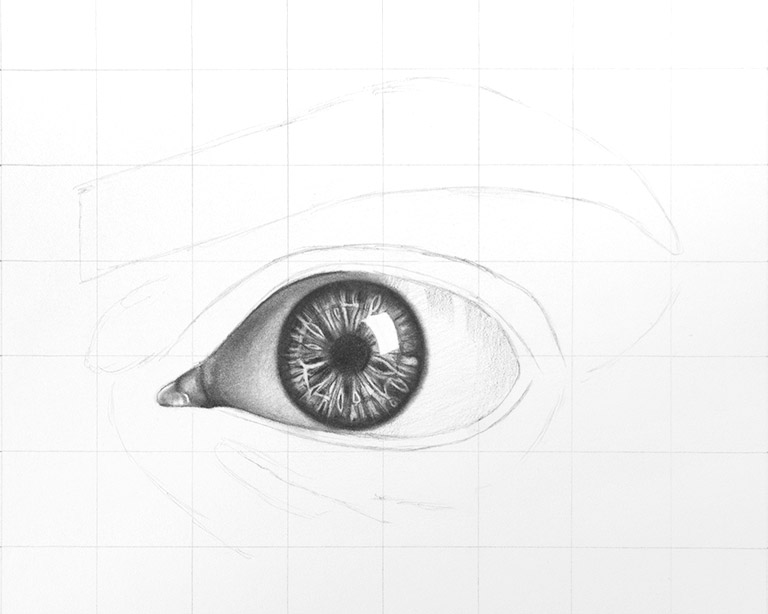
Fill this part with light force per unit area. Add a bit more than shadow in the corner (ball shading!).
As you tin see in our film, lashes can bandage shadows on the eyeball. Include them in your heart drawing by throwing in a few darker lines with a worn out pencil.
Start them at the upper edge of the heart outline. Make their length irregular, so the shadow looks realistic. Remembering the three-dimensional shape of the eye, curve these strokes slightly in line with the roundness of the eyeball (hover your mouse over the paradigm)
-
Blend it with a clean stump

Blend what you've simply drawn with a clean stump. Do not use the one you smudged the darker part with!
The cast shadows should exist blended in the aforementioned mode every bit they were drawn – with strokes starting at the upper lid. Make sure to lower the force per unit area on a stump equally y'all go away from the lid, so the transition from a shadow to a white-ish sclera is smoothen.
-
Right the outline

Draw a dark line separating the upper lid from the eyeball connecting it with the one we've made in step ten.
So, do the same at the bottom hat simply with a lighter tone – there's more light reaching this part of the middle.
Apply an eraser to pause that bottom line with some white, just similar I did. The eye is wet and it usually reflects some light there.
-
Right the contrast in the centre

Last pace earlier nosotros proceed to draw the eyelids:
Wait at your picture from a altitude and encounter if information technology needs any fixes. Add more shadows/highlights where you remember the drawing could use more contrast.
I made the shadows on the left side more prominent to increment depth on my cartoon. I too added a shadow beneath the upper lid. If you hover over the epitome, yous should see a photo from stride 14 overlaying the current progress – use that to run across the changes I applied.
-
Shade eyelid rims
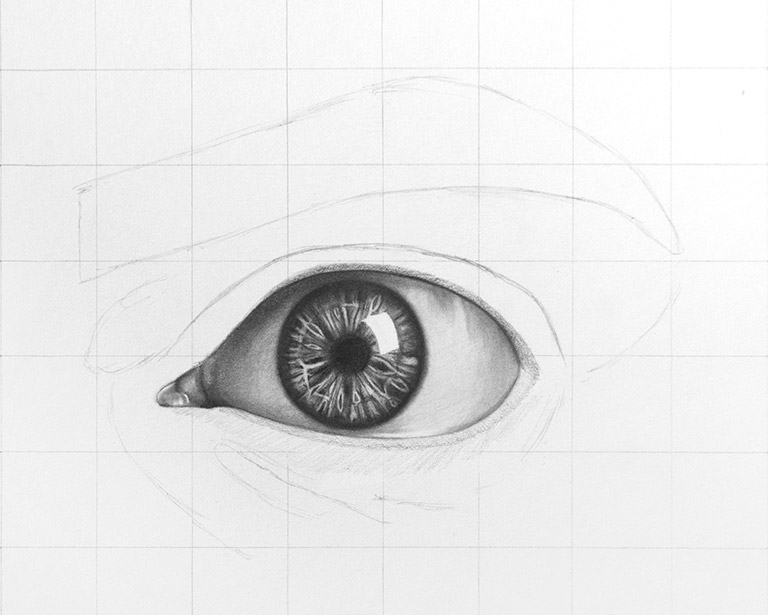
Let'south begin with erasing the outer line on the lower rim almost completely with a kneaded eraser. Leaving it visible is the number one mistake in realistic centre drawing. Later on you've done that fill it with a light shade.
Next, fill the upper rim with a darker tone than the lower ane. The transition betwixt both shades in the outer corner isn't very polish – every bit soon as the lite hits the lower lid it becomes brighter than the upper one.
Y'all can probably see that I also added some frail strokes beneath the lower rim.
Pro tip: Earlier I alloy a border between two shades, I like to have both of them drawn – adding the 2d shade afterwards may result in some strokes going outside that edge and ruining the already polish area of the shade number one.
-
Alloy the rims

Smooth out both lines, starting with a brighter one. Add some tone variation on the lower rim, like a bit of reflection in the outer corner.
-
Shade the upper hat and a brow ridge

First step hither – erase the gridlines that embrace the upper lid area. I didn't and you can see them showing from under the graphite layer. It's unremarkably possible to blend them with the residuum of the epitome, only sometimes they do stay visible. So don't follow my example here. Erase the hell out of them.
Next, refine the pucker line – make it really night and rather thick.
Fill the whole area the way I did. Starting time in the inner corner and finish at the line connecting the crease with the brow. Remember to article of clothing out and tilt your pencil for that.
Looking at our reference photo yous'll see that you should make the left side a bit darker. Same with the area above the crease-forehead line. Follow my sketch along with the shadows you tin can see in the original picture.
Let's also begin shading the crease. You should add together a gradual dark shade below the crease on the left and above information technology on the correct. Expect at the picture to see where the switch really happens.
-
Alloy the area above the middle

Alloy everything with a stump and a castor if you have one.
Pro tip: Using a soft brush (preferably a makeup brush) can help you attain amend results than a blending stump, especially with brilliant shades.
Cross the eyebrow line a fleck, and then that in the next steps you're able to smooth the transition betwixt these areas.
-
Refine shadows and highlights

Simply expect at your drawing and make up one's mind whether it needs more contrast. I drew more shadows in the crease area (added one nether the crease on the right side and darkened the residue of them)
I also used my kneaded eraser to create a highlight on summit of the brow ridge.
-
Shade the space between the center and the nose

Just like in pace 19, let's erase the gridlines starting time.
Then, cover the whole area evenly.
Add some other layer to darken the shadow adjacent to the base of the olfactory organ.
-
Connect it with the upper lid

This is the first part that actually contains the edge of our eye drawing. While blending it, don't forget to fade it out properly to the left side.
Another thing to remember is to cantankerous the eyebrow outline once again.
Connect this office of the peel with the one we've drawn previously so the shading is even throughout the whole upper lid.
-
Add layers below the eye

Again, erase unnecessary gridlines.
Add together a few dots on the lower rim line, so that you can however run across where it should be, fifty-fifty after yous blend the lower lid surface area. Don't worry nigh their visibility – we'll abound eyelashes out of them afterwards!
Fill the remaining skin with gentle strokes. Continue calculation layers in the areas that need more shade. Play with some cross-hatching here o ensure better coverage – modify the direction of strokes in each layer by ninety degrees.
-
Blend the lower lid

Blend everything. Equally e'er, begin with lighter tones.
I used a brush to blend the fair skin at the lesser of the cartoon and stumps for all the darker shades.
-
Add more than depth

Per usual, wait at your middle cartoon and encounter if you should enhance the contrast, aka darken the shadows.
You can too depict a couple of wrinkles in this step. Use gentle strokes to make the finest of lines.
-
Smoothen everything out

If y'all've added new layers, utilize a stump to blend them into the residue of the drawing.
Transitions betwixt shades of the peel should be subtle and soft, then caress them with your brush. Take that same brush – now you have some graphite balance on it – and blend out the edges of your drawing.
-
Introduce peel texture with highlights

This is another footstep you can skip if y'all're creating a less realistic piece. If so, jump to step 30.
Meet all those tiny wrinkles in the eye corner? It's drawing with eraser fourth dimension again!
I used my eraser pen for that – it's super sparse and does a great chore with lines.
Start, describe some lines and spots in the heart corner, then move to the skin on the lower lid.
This texture may await complicated, but I created it past simply stroking the area in ane direction start, and adding some random lines later (preferably in the contrary direction). The goal is to create a blueprint that kinda looks like skin cells – a net of tiny lozenges and triangles.
While I had the eraser in my paw, I besides added some highlights effectually the waterline and on the eyeball.
-
Add together a pop of dissimilarity
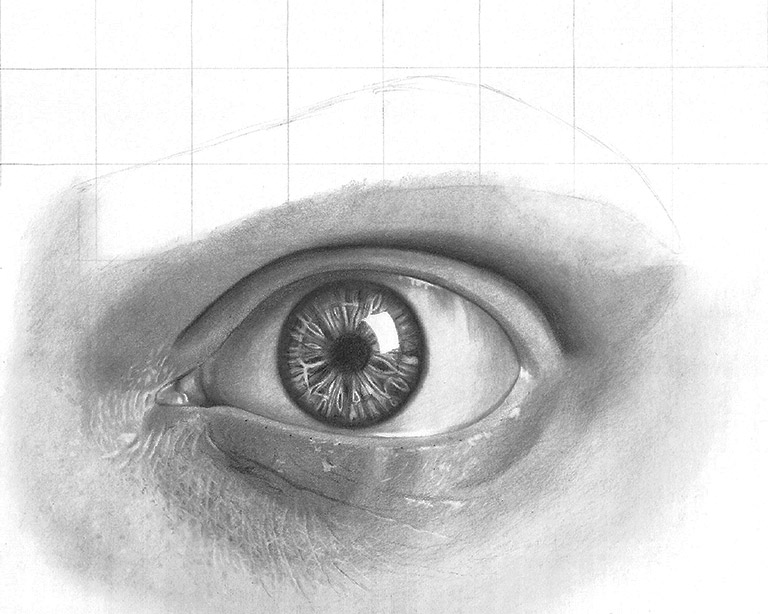
Considering that all the wrinkles and texture are indentations in the skin, yous should pair each highlight with a shadow. Exercise it with a worn out pencil or with a tip of a blending stump.
The calorie-free source is on the upper right, so all the notches should take a shadow on peak or on the correct.
I overlayed this picture with the one from the previous step to help you see the changes I applied.
-
Add veins

While nosotros're at the details, let's add together some veins on the eyeball.
Depict a few irregular lines varying in shade. They have to be really thin, and then apply a rather sharp pencil. Merely don't push information technology also difficult. We desire them to be subtle so they don't overshadow the iris. It's an eye drawing, not a cardiovascular system drawing, wink, flash.
-
Fill the forehead

Erase the rest of the grid.
Shade the forehead (tilt the pencil, cross-hatch)
Next, fill the eyebrow with hairs. We'll alloy them next, so you lot don't have to be precise however. Abrupt pencil, bold strokes. To see the direction of the hairs better hover over the image.
If you're using a different reference picture where the brow is brighter, yous may want to make your strokes softer. Fifty-fifty a subtle change in the shape or color of the brow tin change the face entirely.
-
Blend for (almost) the last time

Alloy the skin on the forehead first. As you can see, I was a petty too sloppy with my cantankerous-hatching, and at present the strokes are pretty visible. Feel free to practice a better job than I did 🙂 I managed to fix information technology later with a brush but why go to so much trouble.
Next, blend the countenance so that it's polish only all the same has some texture. That's a trick I use to create enough thickness without having to depict every single hair.
If y'all're drawing a thinner or brighter eyebrow, your blending should be more gentle than the ane I did on my eye cartoon.
-
Depict eyebrow pilus
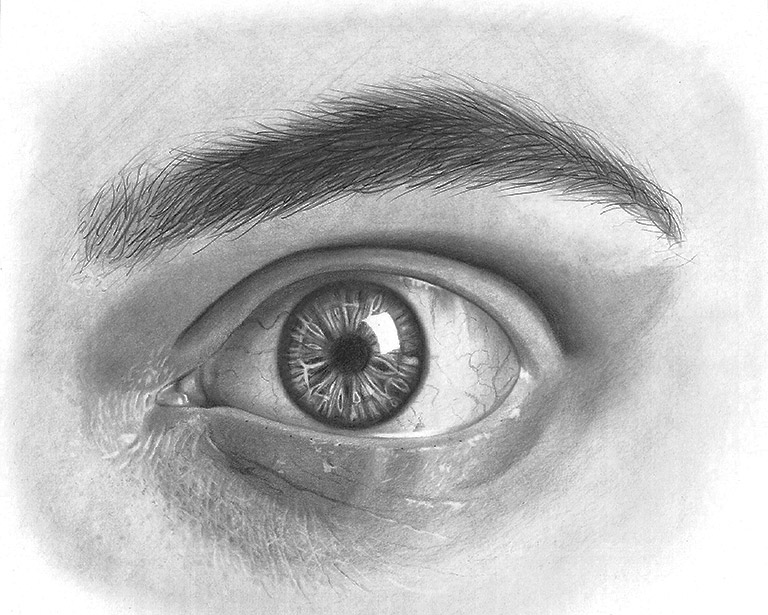
Now we're going to have more fun with the hair.
Kickoff with the left side of the forehead. Notice that these hairs abound near up. They turn to the side above the inner corner of the centre. At the end they plow downward where they besides become shorter than the ones we drew in the middle.
-
Sculpt the brow bone

Past sculpting I mean… adding more shadows, yes! Above the eyebrow, equally well as below it. To exercise that, I dabbed my brush in a patch of graphite residue I made on another piece of paper and transferred it onto my drawing.
Per usual, hover your mouse over the epitome to meet the changes I applied.
You should be able to see that I also added a subtle layer of graphite on the peel texture/wrinkles under the middle to make them softer.
-
Add lashes
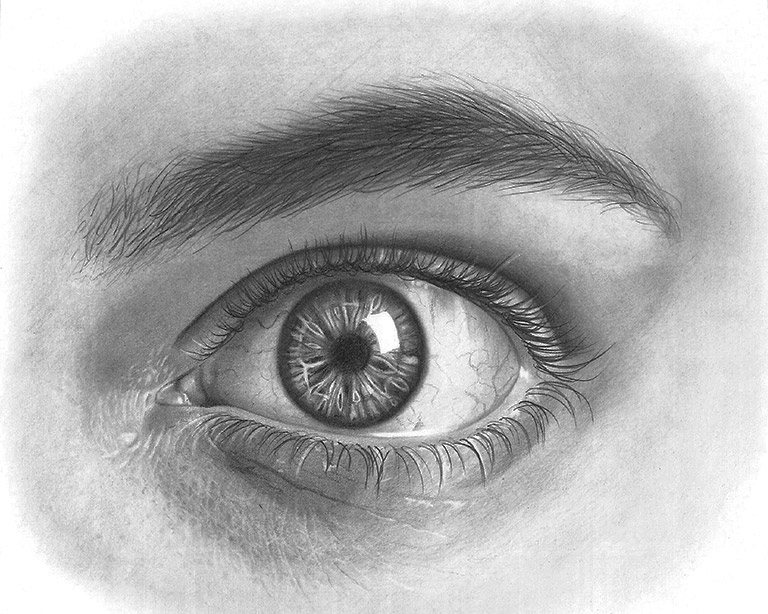
Where you lot start is crucial to the eyelashes cartoon procedure. They should ever abound from the outer line of the chapeau rim, never from the center of it!
Wait at how the shape of the lashes changes on the eye outline. You lot may want to look at this eyelashes drawing tutorial to understand that part of an eye drawing meliorate.
Placing them irregularly is a primal to draw realistic eyelashes.
Don't forget to add a couple of reflections – use a pen eraser to add some white strokes in the lashes.
-
Utilize more than skin texture

Source: https://luizacreates.com/blog/eye-drawing/
Posted by: taylorcultin.blogspot.com


0 Response to "How To Draw An Iris Eye"
Post a Comment